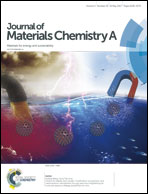A highly stable polyoxometalate-based metal–organic framework with π–π stacking for enhancing lithium ion battery performance†
Abstract
A novel polyoxometalate-based metal–organic framework (POMOF), [PMo8VMo4VIO37(OH)3Zn4][TPT]5·2TPT·2H2O (NNU-11, TPT = tris-(4-pyridyl)triazine), was synthesized. Zn-ε-Keggin fragments were directly connected with TPT ligands generating 2D layers and further interdigitated with each other by π–π stacking interactions to pack into a 3D array. The compound exhibited excellent stability in air and different organic solvents and even in different pH (pH 1–11) aqueous solutions. It can be utilized as an anode material for lithium ion batteries (LIBs) due to the combination of the multi-electron redox property of POM units and the functionalization of MOFs. NNU-11 exhibited a highly reversible capacity of 750 mA h g−1 at a current density of 50 mA g−1 after 200 cycles along with excellent cycle stability and rate performance. More importantly, for the first time, we designed and synthesized a POMOF crystalline structure model supported by π–π stacking interactions to demonstrate that intermolecular π–π stacking interactions are beneficial to promote the performance of LIBs.



 Please wait while we load your content...
Please wait while we load your content...